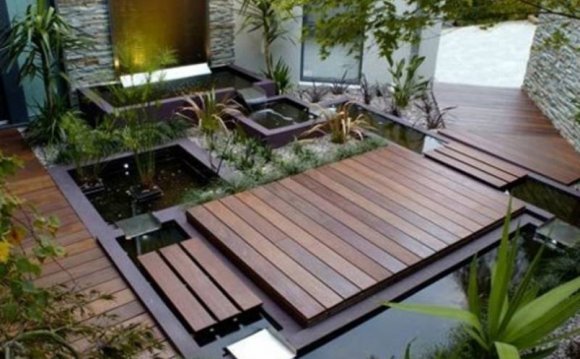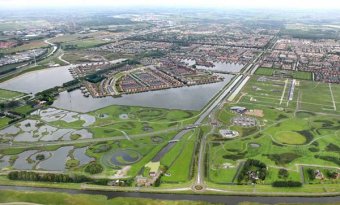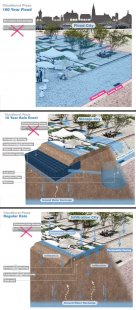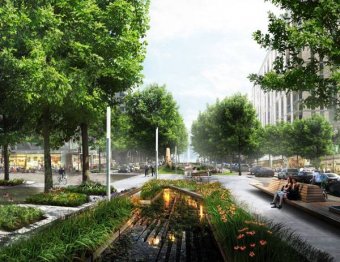
 4. ECOLOGICAL
4. ECOLOGICAL
Orongo Station by Nelson Byrd Woltz in Poverty Bay, North Island, New Zealand
Water not only sustains humans, but wildlife depends on it also for its ecological value. Unfortunately, human activity has changed natural water systems and degraded critical wildlife habitat, but the field of restoration seeks to address issues facing habitat loss to bring back functioning ecologies.
Nelson Byrd Woltz is leading the field in the integration of water, restoration ecology, and agriculture. As part of their conservation agriculture studio, the Conservation Master Plan for Orongo Station in Poverty Bay, New Zealand, restored wetlands to use water as an ecological driver. Historically, the wetlands were drained to be converted to grazing lands and one of the objectives of this project was to bring them back. However, these are no ordinary wetlands – they were designed as a living piece of art.
Two kilometers of deep river winds through seventy-five acres of constructed wetlands. Inspiration was taken from the landscape architect Roberto Burle Marx and his highly abstract work. Freshwater wetlands and salt marsh brought back native ecologies and now provide habitat for the native flightless birds on the island. This project conserves places that should have never been farmed while integrating them into the cultural landscape of the native Maori people.
 WATCH >> From landscape architecture to conservation agriculture | Thomas Woltz | TEDxCharlottesville
WATCH >> From landscape architecture to conservation agriculture | Thomas Woltz | TEDxCharlottesville
Pre-treatment swales gather freshwater, filter it with plants, and hold it in the wetlands until it can be infiltrated. The agricultural fields were rearranged to accommodate the restoration and their edges were forested to protect the citrus crops. This integrates human activity with natural systems that work in harmony. Landscape architecture has the potential to push this idea and use water to our advantage, and other species’ advantage, as well.
3. PURIFICATION
Using water in design is not just about collecting and infiltrating. Purifying the water and cleaning up the pollution it carries not only leads to a healthier community, but a healthier environment. Water management can be subtle, or in-your-face, like Park van Luna in the Netherlands. Here, a residential development is integrated with recreational opportunities and a large body of water that reduces floods, preserves wetlands, and harvests stormwater. Part of the larger City of the Sun, the whole development will run on renewable solar energy, making it carbon neutral.
 It is on an island, surrounded by a 60 ha lake, so it just makes sense to embrace the water and manage it in a unique way. Reducing our climate footprint, while preserving the environment, is how the field should push new development in the future.
It is on an island, surrounded by a 60 ha lake, so it just makes sense to embrace the water and manage it in a unique way. Reducing our climate footprint, while preserving the environment, is how the field should push new development in the future.
Out of a total of 177 ha, 75 ha are dedicated to open space and sports; activities that promote social interaction. A 1 km beach, sports center, and walking /cycling paths, encourage a healthy community. In regards to using water, this project excels in the purification of the water it is so integrated with. A natural purification plant, a de-phosphatizing pond, and a pumping station all encourage residents to interact with and learn about the systems. The system was also designed to store a large amount of water to be used during the summer months.
2. HOLD AND RELEASE
Another revolutionary way to use water is to hold it, and then release it gradually in order to lessen the burden on conventional water treatment systems. This decreases CSO overflows and allows treatment plants or natural bodies of water to slowly deal with the ever-increasing occurrence of floods which climate change is causing today. Waterplein Benthemplein in Rotterdam, the Netherlands, utilizes public space to address the issue of floods.
Three concrete basins were designed to hold water, then release it slowly. This is truly a unique way to design multi-use public space. One of the basins is fed by a waterfall which directs rain water into it, and the others are graded to collect surrounding runoff to fill up.
In dry weather, each basin has a different use. People utilize them for seating, football, and volleyball. Intimate spaces are created with plantings that uptake the water as well. Rotterdam is a city of water, and dealing with it in the public square is an in-your-face way to create multi-functional spaces that increase the efficiency of stormwater management while educating the community. The temporary storage of excess rain water can increase the efficiency of our infrastructure and show us what really happens when it rains.
WATCH >> Waterplein Benthemplein
1. SMALL SCALE SITES ADD UP
One of the most efficient and easily-implemented ways to deal with water in the environment is through a network of small-scale interventions that mitigate runoff and pollution. Designing a system is what works, and is how new development should be tackled – it creates a cohesive landscape that addresses issues in every way. Imagine if every new renovation and street incorporated stormwater plantings on it. The benefits add up quickly and result in an efficient system overall.















